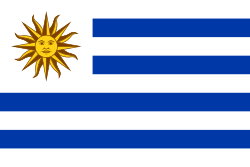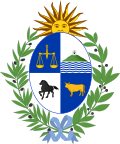

The following outline is provided as an overview of and topical guide to Uruguay:
Contents
- General reference
- Geography of Uruguay
- Environment of Uruguay
- Regions of Uruguay
- Demography of Uruguay
- Government and politics of Uruguay
- Branches of the government of Uruguay
- Foreign relations of Uruguay
- Law and order in Uruguay
- Military of Uruguay
- Administrative divisions
- History of Uruguay
- History of Uruguay, by period or event
- History of Uruguay, by region
- History of Uruguay, by subject
- Culture of Uruguay
- Art in Uruguay
- Sports in Uruguay
- Economy and infrastructure of Uruguay
- Education in Uruguay
- See also
- References
- External links
Uruguay – sovereign country located in southeastern South America. [1] It is home to 3.46 million people, of which 1.7 million live in the capital Montevideo and its metropolitan area. Montevideo was founded by the Spanish in the early 18th century as a military stronghold. Uruguay won its independence in 1825-1828 following a three-way struggle between Spain, Argentina and Brazil. It is a constitutional democracy, where the president fulfills the roles of both head of state and head of government. The economy is largely based on agriculture (making up 10% of GDP and the most substantial export) and the state sector, Uruguay's economy is on the whole more stable than in its surrounding states, and it maintains a solid reputation with investors.




